Dunlop Geomax MX33 First Ride Impression
Just when you thought you had all the traction and performance you could get
There comes a point in every motorcyclist’s life when they reach a certain level and realize that tires aren’t all created equal. I’ve owned and ridden on just about every major manufacturer’s off-road offerings, but I never really gave too much thought to tire selection beyond condition type and price point. I always figured, if the knobbies still had a decent edge, I was getting about as much traction as I could get. I just chalked the faster guys up to being better, more skilled riders – which is true of course – but I didn’t realize how much of a difference a particular tire could make until one of my riding buddies, an ex-Factory Honda rider from the late ‘80s/early ‘90s, told me to check out the Dunlop Geomax MX3S.
That was three years ago, and I haven’t used a different tire since, in the front anyhow. It was a revelation. All of a sudden, it felt like I had more traction than ever before, and my confidence and speed began to increase almost instantly as a result. I could push the front harder and deeper into a turn, and it would stick better than others in the past. In the rear, I would usually run the 3S as well, or sometimes the MX52 (Dunlop’s intermediate to hard terrain tire) for more durability in the desert, trails or anywhere off the track, but my rears were mostly whatever I could get my hands on.Just when I thought I had all the traction and performance a rider could get, Dunlop releases the Geomax MX33, the successor to the MX3S. To better understand how and why the MX33 was developed, we need to talk about the 3S predecessor a little bit more. Be it Supercross or Outdoor Nationals, the Geomax MX3S has been the tire choice of just about every top amateur or pro rider in the AMA circuit since it was launched in 2014. According to Dunlop, 90-95% of riders that qualified into Supercross main events since the tire’s release were running the 3S.
Additionally, 80% of the best amateur riders in the U.S. competing at the 2017 Loretta Lynn Amateur Nationals chose the MX3S, and 36 out of the 36 individual class championships were won on this tire.
With these types of statistics, no other tire manufacturer even comes close. Clearly, Dunlop is onto something. So, how does Dunlop improve on arguably the best tire already on the market?
“To make a change to something so successful, and to improve on it is definitely a challenge. But we feel like we did that with the 33,” said Broc Glover, Dunlop’s Senior Off-Road Motorcycle Manager. “We have access to every factory team, every factory-supported team and every top team out there. All the way from the Jason Andersons, Marvin Musquins and Eli Tomacs, to the Pro Circuit, Star Racing and Geico Honda Teams, we have all these top teams and engineers – the best riders and smartest minds in our sport. We have access to feedback from them, how the tires do on each brand or size of bike, and data from different conditions over 17 rounds of Supercross and 12 Outdoor Nationals. So, we would be fools not to take advantage of the input from the world’s fastest riders and their technicians.”
There were two main areas in which Dunlop wanted to improve upon the MX3S: First and foremost was durability, and second was overall incremental improvements in performance based on all the feedback the company received over the years. The MX3S was designed for use in soft to intermediate terrain, but due to its outstanding performance and popularity, most riders (myself included) have been using it as their go-to all-around tire for all types of riding conditions, including rockier, desert type terrain that often times has lots of sharp edges and rough surfaces that can quickly shred tires.
Knowing when to replace the front 3S was easy. As soon as the outer knobbies began to shear away from the carcass (or tear off completely), you knew you were due. Depending on how aggressively you ride, unfortunately, this would often happen before the rest of the middle knobbies showed signs of comparable wear. This was usually a bummer because sometimes the tire was toast before the orange lines wore off completely. But again, this was usually due to the fact that I’d run the 3S in terrain it wasn’t exactly designed for. Can’t we just have it all?
To combat this, the MX33 features not only an all-new tread pattern, but more importantly, its patented Progressive Cornering Block Design (more commonly known as Block-In-A-Block technology) as well as tie-bars between the middle to outer knobs. Dunlop has used Block-In-A-Block technology for years now in its rear tires, but the MX33 is the first tire to incorporate it in the front. Not only is the new inner diamond-shaped block larger, which adds more surface area and two additional angles to improve traction, but the tie-bars also provide higher resistance against tearing when ridden on rougher terrain.
With these changes, Dunlop created a tire with a greater range of capabilities. Additionally, the MX33 also incorporates a new rubber compound with a higher molecular weight polymer to improve the tire’s durability and a carbon micro-particle to increase its grip. Now we’re talking.
The new Geomax MX33 also features what Dunlop calls Multiple Block Distribution, which has altered the knob distribution over the outgoing 3S. In addition to creating an aggressive look, Multiple Block Distribution technology increases the number of knobs on the shoulders and center of the tires, and also varies the height and angles of the knobs within the tread pattern. Dunlop says this translates to more biting edges and more traction, creating superior grip and increased handling performance over the MX3S.
While these changes certainly alter the look of the MX33 compared to the MX3S from the outside, Dunlop engineers tweaked the new 33’s internal carcass underneath the tread, using a process they call Advanced Apex Design. The new construction of the front and rear tires incorporates the same sidewall material used in the MX3S, however the MX33’s design features a taller, thinner apex within the sidewall. Dunlop says that, without adding weight, this construction delivers superior shock absorption, more uniform rigidity in the sidewall, and a smoother ride with firmer feel. With this new design, Dunlop optimizes the distribution of tension of the components so the tire absorbs more shock, but flexes when necessary to smooth out ride characteristics, allowing the bike to track in a straighter line.
All these improvements sound great on paper, but how do the MX33 tires actually perform when the rubber meets the dirt? We were invited to Zaca Station to find out. Located in the rolling hills of Santa Barbara’s wine country, Zaca is about as close to moto-nirvana as you can get. The dirt there is a combination of a soft, sandy soil on top of a harder, more slippery base, and there’s no easier way to feel like a hero off-road than with a wall of fresh rubber driving you.
In the morning, when the track is fresh and lines are yet to get burned in, the track’s top layer can sometimes be tough to navigate depending on how finely or coarsely its been tilled, meaning you can often times get pushed around with a vague feeling in the front until lines get more established. It’s in this type of terrain where I’ve always struggled the most because I’ve never been one to just lay it over and let it rip. I grew up in the Pennsylvania woods riding mostly trails and GNCC type courses with rocks and roots to contend with, so I’ve always considered myself to be more of a technical rider rather than one to just pin it and let it all hang out. I prefer to choose my lines more deliberately, using the terrain’s features to deflect off of and use to my advantage.
In this softer stuff, The MX33 front really lets you knife through and steer wherever you want, even with steeper lean angles before any sort of ruts or berms begin to form. Multiple times I found that when I felt the front start to push through a turn, whether it be due to soft or loose terrain, or the application of too much front brake while leaned, the MX33 would dig in and regain its composure (or perhaps more accurately, my composure). This was always something I loved about the MX3S, and I feel like the front tire’s ability to regain traction like this really inspires confidence in the dirt.
Though I only have a few hours of seat time on the MX33, my initial feeling is that the 33 is able to bite even harder with its outer knobs due to their Block-In-A-Block construction. It felt like those added raised angles allowed me to push my own limits in the soft stuff a little further than what I’m accustomed to. Once actual lines started to form, I found that the front tracks really well, too, especially when transitioning from the smoother, cut in lines to the fresher, more virgin ones. If I was on an outside line and wanted to cut across to the inside, or vice versa, I was able to do so with very little to no twitchiness whatsoever in traversing the different terrain. Steering from the smoother dirt across and into the untouched stuff, the MX33 kept the bike pointed right where I wanted it, which is pretty awesome and confidence inspiring as a resuly, particularly when passing a slower rider riding in the main line.
I also found the front MX33 to be more composed in the hard pack too. I noticed it mostly on drier surfaces like jump faces. I felt way more comfortable and confident carving up the jumps and taking off at an angle as opposed to trying to hit them more squarely before. Additionally, harder braking in firmer conditions is improved over the MX3S as well. As you get on the brakes and the force squishes the front tire down, the tie-bars keep the tire from flattening and folding over as much. Of course, this depends largely on how much pressure you like to run, but Dunlop has actually found that most riders are beginning to prefer to run 13.5 to 14 psi in the front MX33 compared to 12 to 13 psi before. This is largely due to the increased shoulder bite and more consistent and linear tire flex due to the addition of tie-bars.
In the rear, I found the MX33 to hook up nicely, too. Straight-line traction is great, which keeps your front end nice and light under hard acceleration, making getting over the bumps and rollers easy, but the biggest advantage I found was on the gas while leaned over. The MX33 rear, to me, felt more planted and it tracked in a straighter, more predictable fashion than the 3S. I don’t know if it necessarily felt stiffer, as the taller, tapered sidewall construction would suggest, but it definitely communicated less skatiness while on the throttle which helped me power harder through a sweeping turn and focus on the next obstacle.
I really enjoyed the planted feel the 33 rear delivered, but rear tire choice is more subjective from rider to rider. I know some guys who prefer to slide the rear around more, whether it be brake sliding or simply steering with the gas. Like I mentioned before, I like to be a little more deliberate and smooth with my line choice, so I really dig the way the MX33 bites and hooks up with less fear of it stepping out on me. Dunlop engineers and test riders have found a good balance to keep all riders happy. Dunlop Senior Test Engineer, Clark Stiles sums it up nicely:
“Proper grip characteristics are key: too much bite doesn’t allow you to slide or brake slide as needed; too little traction doesn’t return enough control when you want the bike to slide in a predictable manner. The goal was to create a well-adjusted amount of traction, absorbability, handling and slide control without compromising on durability. We were able to do that with the MX33.”
All in all, I think Dunlop took a great product, improved upon it and raised the performance bar. Having only one ride on the MX33 tires so far, durability is obviously yet to be tested, but you can expect us to report back on that at a later time. The Geomax MX33 is currently available for purchase through all the major tire retailers and dealerships with a size for every type of bike. Additionally, Dunlop has also introduced a new 120/90-19 size as well (Ken Roczen’s tire of choice), a slightly taller tire than the 120/80-19, which aims to help even more with bump absorption. I’m looking forward to testing the MX33 at different tracks with various types of dirt as well as off-road in the desert and on the trails to see how it holds up and performs. In the meantime, it’s definitely safe to say you won’t be disappointed if you choose to wrap your wheels with some 33s.
In Gear
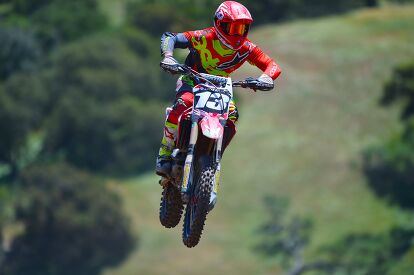
Helmet: 6D ATR-2 $695.00
- Goggles: Scott Prospect $90.00
- Gear: Alpinestars Techstar Venom $229.90
- Boots: Alpinestars Tech 10 Starting at $599.95
More by Brent Jaswinski

































































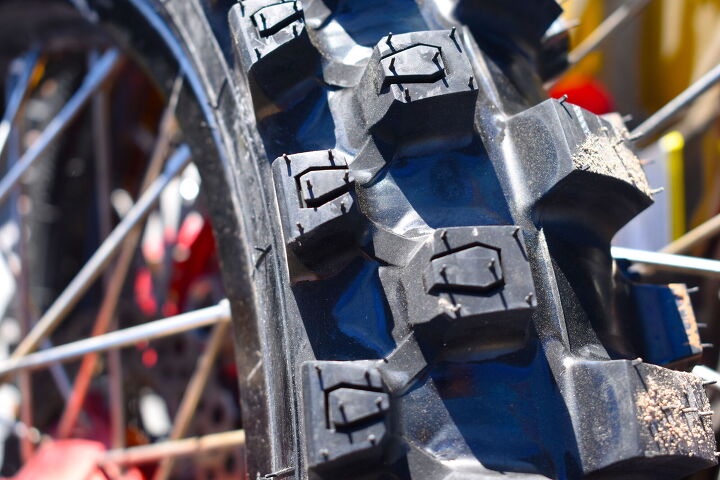









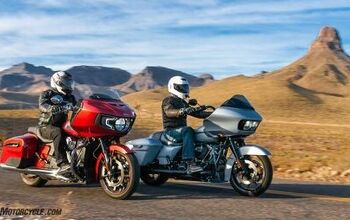
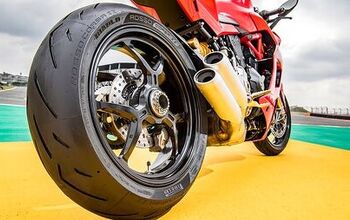






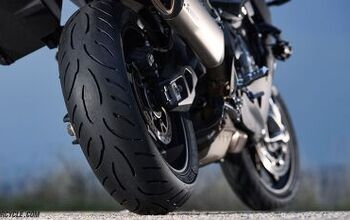








Comments
Join the conversation
Wow, what a track!
Interesting. As an off road rider who covers a lot of distance and rides over gnarly rocks and stuff, front tire life and not having the damn side knobs tear off is a real consideration. I treat the rear tire as a rim protector and run Sedona tires on the back as they are cheap, work decent, especially with a TuBliss system running low pressure, and they last.
This might be an interesting front tire to try. I care a lot more about front tires than rear tires on my 300cc two stroke. The rear spins all the time anyway. When the front lets go too badly, sometimes I fall down and/or hit things - LOL